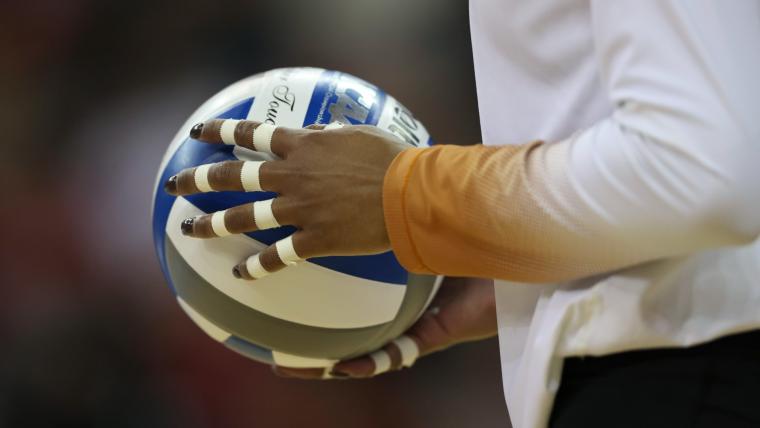New fan or old, the rules of volleyball can be a little confusing.
What does that referee's motion mean? What's a libero? How do players get so tall?
Fortunately, volleyball is pretty straightforward about 99 percent of the game, especially in a good, clean match. That doesn't mean it all makes sense. There are violations and rotation rules that are so rarely called by referees, you forget they even exist until the whistle is blown.
But don't let it scare you. Volleyball is such a game of highs and lows that even unusual calls can shift the entire outcome of a game. Here are the basics to know as you watch:
MORE: Schedule, TV channels for NCAA volleyball final four games
Volleyball rules, explained
In college volleyball, matches are played best three of five sets. The first four sets go to 25 points while the fifth set goes to 15. However, teams must win by at least two points, so sets can exceed the scoring goal.
Scoring a point
There are many ways to score a point but few without violation.
Hitting the ball in or out automatically determines who gets a point. If Team A hits the ball outside the other side of the court, it is Team B's point. The antennas placed on either side of the net help determine the out-of-bounds line. If the ball crosses the outside or over the top of the antenna, or touches it at any point during a rally, it is considered out.
If Team A hits in inside the court, Team A scores. The inch-wide lines that outline the court are considered in-bounds; if the ball touches the line at all, it is still considered in. When the ball is hit into the net, the point is rewarded to the other team.
Things can get a little dicey with touches. The last team to touch the ball before it goes out of bounds loses the point. These touches can be clear as day or microscopic, especially at a blocker's fingertips, and can be a source of contention.
Violations
Violations determine points, as well, but are more rare. However, there are a handful of violations in volleyball.
They can best be condensed into three main categories:
1. Ball handling
While rare, ball handling mistakes happen and are violations. Doubles are when a player touches the ball twice in a row. It isn't always obvious when this happens, as poor sets can get called for doubles. However, a block touch is not considered an individual touch, so the player may make another play on the ball, and the team still gets three touches after it.
Lifts are called when a player contacts the ball with an open hand and pushes it upward. Throws are a similar violation, but occur when a hitter open-hands the ball and drags it backward before pushing it forward.
2. Net fault
Players may not touch the net during a rally at any point. If they do, the point is awarded to the other team, no matter the rally's result. In NCAA rules, a player's jersey may not touch the net but their hair is not considered a violation.
3. Foot fault
Foot faults may happen at the service line, center line or attack line.
During a serve, players may not touch or cross the end line until after they contact the ball.
Specific rules apply to center line violations. Players may touch or cross the line under the net so long as it does not interfere with the play or an opponent. However, if their foot crosses the line entirely, it is a violation, whether it interferes or not.
The attack line, known as the 10-foot line, is that distance from the net on either side and separates front-row attacks from back-row attacks. Back-row players may jump and attack the ball, so long as they stay behind the attack line, which has the same violation as the service line. They may land in front of the line but must leave the floor from behind it. If a player jumps in front of the attack line and sends the ball over the net, it is considered a back-row attack violation.
Challenges
NCAA volleyball coaches may challenge a point once the play is concluded. Teams get two challenges each for the entirety of the match but may lose them.
Only a few calls can be challenged, but multiple violations may be reviewed at once by the officiating team. For example, a touch may be reviewed at the same time as an in-or-out challenge. These calls are subject to review:
- In or out
- Touch
- Net violation
- Foot fault
Subjective calls, such as ball handling or interference, can not be challenged.
If a challenge results in the call's reversal, the team keeps the challenge. If the call stands or if confirmed, it means there was not enough video evidence to overturn it. The team loses its challenge. Coaches are awarded an additional challenge if the match goes to a fifth set, whether they already used all or none of their challenges during the game.
Volleyball rotations and substitutions
In volleyball, the six players on a court will move spots because of rotations.
Teams rotate on their side of the court after they sideout, or earn a point after losing the previous one. You stay in that rotation so long as you keep winning the point. There are three rotations in the front row and three in the back.
As players move on the court, some will stay in, some will be substituted out. Teams have 15 substitutions they may use per set. Liberos, however, do not count as a substitution because of their designation, allowing them to move freely on and off the court.
What is a libero in volleyball?
Everyone's favorite volleyball question: "Why is that player wearing a different jersey?"
A libero, who can be identified as wearing a jersey different from the rest of the team, is a designated defensive specialist. This player has unique rotations and substitution rules.
Liberos may enter for any player in the game, so long as they are in the back row; liberos cannot play front row. The NCAA allows them to serve, something typically prohibited in professional leagues. However, they may only serve once. For example, a libero may enter for Player A and Player B but can only serve in place of one of their teammates, not both.

